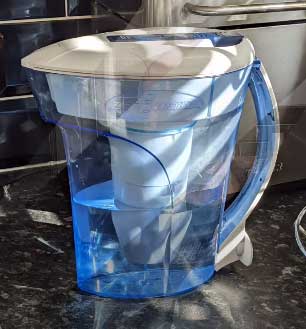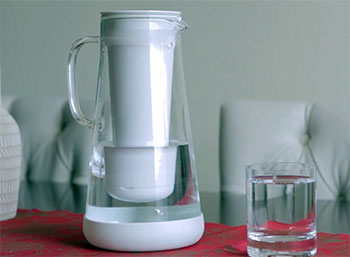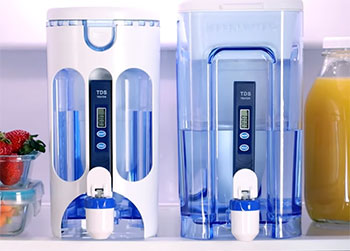Drinking clean water is more than a necessity. It’s a crucial factor to our health, especially in an era where pollution and contaminants are prevalent.
However, picking the right water filtration system can be a challenging task, especially when the market is flooded with numerous brands.
Today, we take an in-depth look at two popular options: the Lifestraw and ZeroWater water filter pitchers.
A Brief Comparison Table
| Feature | LifeStraw | ZeroWater |
| Purpose and Usage | Outdoor and emergency use | Household use |
| Filtration Process | Two-stage filtration (microfiltration membrane, carbon capsule) | Five-stage filtration process |
| Removal of Contaminants | Bacteria and parasites | Nearly all dissolved solids, including heavy metals, pesticides, and other chemicals |
| Water Volume | Filters up to 1,000 gallons (4,000 liters) during its lifespan but only a small amount at a time | Filters large volumes at once, cartridges need to be replaced after 20-40 gallons, depending on input water quality |
| Cost and Maintenance | Low initial cost, almost no maintenance cost | Higher initial cost, ongoing costs due to filter replacements |
LifeStraw Water Filter: A Rugged Companion

LifeStraw is renowned for its lightweight, portable design, making it a favorite among outdoor enthusiasts.
Notably, this filtration system can filter up to 1,000 gallons (4,000 liters) of contaminated water, removing 99.9999% of waterborne bacteria and 99.9% of waterborne protozoan parasites.
- Pros of LifeStraw
The LifeStraw is incredibly user-friendly, requiring no electrical power or spare parts during its lifetime.
This makes it a reliable companion for hikers, campers, and anyone spending time in remote locations with questionable water quality.
Furthermore, the LifeStraw manages to filter water instantly, allowing you to drink directly from the source, which is another significant advantage for those in outdoor environments.
- Cons of LifeStraw
On the downside, the LifeStraw’s key features become its limitations in everyday home use. The product’s design doesn’t cater to filtering large amounts of water at once, which means it might not be the best choice for families or for cooking purposes.
Additionally, LifeStraw doesn’t filter out chemicals, heavy metals, or viruses, which could be a concern for some users.
ZeroWater Water Filter Pitcher: Home Water Purification Redefined
ZeroWater filter pitchers offer a comprehensive filtration solution for households. Unlike LifeStraw, ZeroWater specializes in home water filtration, targeting not just bacteria and parasites but also dissolved solids and heavy metals.
- Pros of ZeroWater

The ZeroWater filter pitcher uses a five-stage filtration system, removing 99.6% of total dissolved solids — a feat unmatched by many other household pitchers.
It even comes with a water quality meter, enabling you to test your water before and after filtering to assess its quality.
- Cons of ZeroWater
Despite its robust filtration system, ZeroWater pitchers do have their drawbacks.
Firstly, they can be relatively slow, filtering water at a slower pace than some other market options.
Additionally, while the filters are effective, they can require frequent replacement, especially if your tap water has high levels of total dissolved solids, leading to increased maintenance costs.
Key Differences Between LifeStraw and ZeroWater
When comparing LifeStraw and ZeroWater, it’s clear that these water filters cater to different segments of the market. Here, we break down the key differences between them.
Purpose and Usage
LifeStraw is designed with the outdoors in mind. It’s perfect for campers, hikers, and explorers who need to filter water from natural sources. Because of its compact and lightweight design, it’s excellent for personal use in emergencies or in areas with unreliable water sources.
On the other hand, ZeroWater is a household water filter pitcher that’s meant for home use. It’s designed to filter tap water, making it safer and tastier for drinking and cooking. Its primary function is to provide filtered water for the whole family.
Filtration Process
The filtration process is another significant difference between the two. LifeStraw uses a two-stage filtration process, which includes a microfiltration membrane and a carbon capsule. This combination effectively removes most bacteria and parasites but doesn’t tackle chemicals or heavy metals.
ZeroWater, meanwhile, uses an impressive five-stage filtration process. This process removes virtually all dissolved solids from water — including heavy metals, pesticides, and other chemicals — offering a more comprehensive filtration solution for your home.
Water Volume

However, it can only filter a small amount of water at a time, which aligns with its design for personal, immediate use.
Another key difference is the amount of water that each device can filter. LifeStraw can filter up to 1,000 gallons (4,000 liters) of water throughout its lifespan.
ZeroWater pitchers, depending on the model, can hold between 6 and 40 cups of water. They are designed to filter large volumes of water at once, which is great for families.
However, the filter cartridges do need to be replaced periodically, with each cartridge capable of filtering approximately 20-40 gallons of water, depending on the quality of the input water.
Cost and Maintenance
While the initial cost of a LifeStraw is less than a ZeroWater pitcher, the maintenance costs are almost negligible since LifeStraw doesn’t require any filter replacements.
ZeroWater, though costlier initially, has ongoing costs because the filters need to be replaced after filtering a certain amount of water. The frequency of replacement can add up, especially if the tap water being filtered has high levels of dissolved solids.
These are the critical differences between LifeStraw and ZeroWater. Understanding these distinctions can help you determine which water filter better suits your specific needs and lifestyle.
Ease of Use
Both pitchers are simple to use:
Lifestraw
- Fill pitcher from tap
- Water filters through in about 60 seconds
- Pour filtered water into glass
ZeroWater

- Fill pitcher and wait for filter indicator to turn green
- Pour water into glass or pitcher reservoir.
The Lifestraw reservoir holds the filtered water so you don’t have to wait. ZeroWater has a smaller reservoir that requires refilling from the top chamber.
Lifestraw has a filter change reminder sticker that shows when to swap filters. ZeroWater displays filter status through the electronic TDS meter.
Overall, Lifestraw seems a little simpler to use while ZeroWater gives you an objective way to monitor filter effectiveness.
Water Taste
Anecdotal evidence from customer reviews suggests both Lifestraw and ZeroWater produce good tasting water, remove chlorine odor and improve flavor.
ZeroWater may have a slight edge since it reduces TDS and any mineral tastes. But Lifestraw also eliminates bad tastes and odors quite effectively.
Bottom line – both pitchers significantly improve upon tap water flavor.
Certifications
- Lifestraw Home is tested against NSF standards and certified by the EPA, CE, and SASO.
- ZeroWater is NSF certified to reduce contaminants including lead.
So both brands have undergone independent testing to validate their filtration claims.
Filtration Effectiveness: What Do They Remove?
Both Lifestraw and ZeroWater remove the basic contaminants like lead, bacteria, pesticides, chlorine byproducts, asbestos fibers, microplastics and pharmaceuticals.
But ZeroWater has one clear advantage – its ion exchange filter removes up to 99.6% of total dissolved solids. TDS is a measure of all inorganic salts and minerals dissolved in water. High TDS water can have a bad taste, odor, and potential health risks.
The ion exchange resin attracts and binds to positively charged dissolved minerals like calcium, magnesium, and sodium. This allows ZeroWater to reduce TDS down to just a few parts per million.
Lifestraw Home doesn’t reduce TDS – its focus is on filtering out pathogens and toxic contaminants. If you live in an area with very hard water rich in minerals like calcium carbonate, the ZeroWater pitcher would be the better choice for reducing scaling and improving taste.
Frequently Asked Questions (FAQ)
Determining the “best” filtered water brand largely depends on individual needs. If you’re looking for outdoor or emergency use, LifeStraw offers superior portability and ease of use. For comprehensive home water filtration, ZeroWater could be the best choice due to its multi-stage filtration process.
ZeroWater filter pitchers offer a thorough, five-stage filtration process that removes nearly all dissolved solids from your water — a feature not found in many other pitchers. This makes ZeroWater potentially better for those looking for the purest taste and lowest contaminant levels.
Yes, ZeroWater filters are healthy. They remove many potential contaminants from your water, including heavy metals, pesticides, and other chemicals. However, remember that water filtration systems should complement, not replace, safe water sources.
While Brita is another popular brand, it generally only removes chlorine taste and odor, along with some metals like mercury and copper. ZeroWater, on the other hand, offers more comprehensive filtration, removing nearly all dissolved solids.
Absolutely! ZeroWater filters work by passing water through five filtration stages, each designed to remove different types of contaminants. The effectiveness of these filters can be easily seen with the provided water quality meter.
Final Thoughts
Choosing between the LifeStraw and ZeroWater water filter pitchers ultimately comes down to your individual needs. The LifeStraw is perfect for on-the-go individuals, particularly those who love camping and hiking.
However, for comprehensive household water filtration, ZeroWater offers a more detailed approach. Remember, clean water is not a luxury — it’s a right, so invest wisely.
